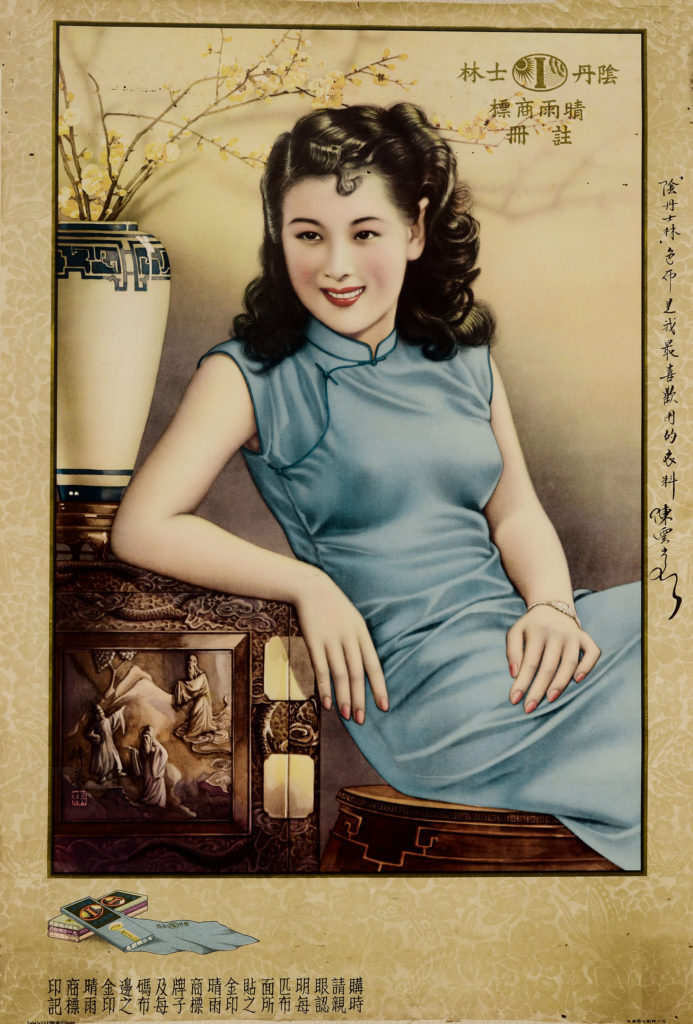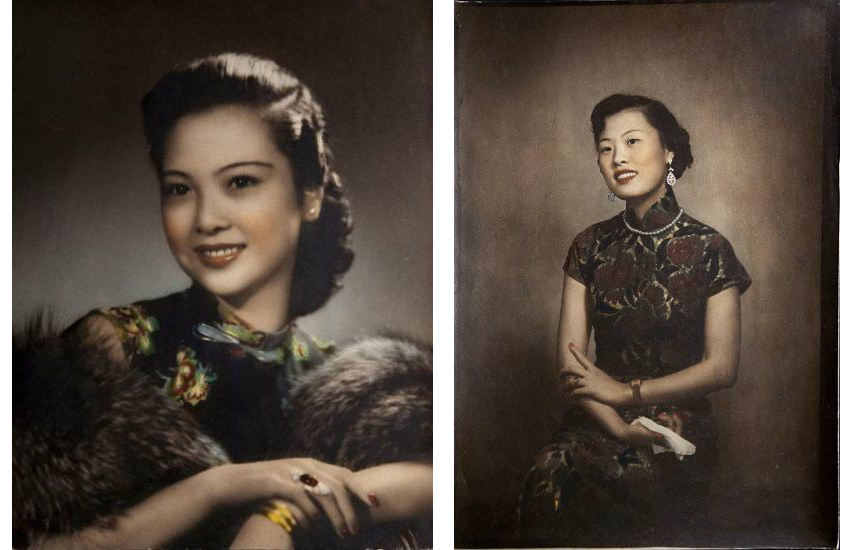
A picture that epitomises qipao’s golden era, 1930s. A girl dressed in a vibrant floor length qipao, set against the backdrop of 1930s Shanghai; A Prosperous City That Never Sleeps, 1930s. By Yuan Xiutang (dates unknown) collection of the Shanghai History Museum
I have to admit, I was pretty impatient to get to this third post on the history of qipao (or Cheongsam in Cantonese). The Qing dynasty and 1920s were interesting periods for qipaos in their own right (see the previous two posts here and here), but the 1930s is what I am really excited about.
This was truly qipao’s golden era – the celebrities, the movies, the advertisements and posters that still remain popular today… and of course, the dresses themselves, in a dizzying array of colours, patterns and fabrics.
So that’s why I decided to write this dedicated post to qipao’s golden era, 1930s – hope you enjoy it as much as I do.
Qipao and the Paris of the East: Shanghai
By the 1930s, Shanghai had well and truly developed into the center of East Asia. A principal trading port for China, it was one of the biggest cities in the world with over 3 million people. A sophisticated, cosmopolitan city, it was a melting pot of Chinese and Western cultures; a hub for music, cinema, celebrity and fashion. And it was during the 1930s that the development of qipao became inextricably linked to the development of Shanghai.
Shanghainese tailors became renowned for their speed, innovation and craftsmanship. The latest European and American fashion trends from popular magazines (画报/畫報) would be adapted into qipaos within a matter of 3-4 months, ready for purchase. Department stores and textile manufacturers hosted fashion shows. Celebrities, fostered by the Shanghainese film companies, competed and off screen in their latest qipao creations.
Most famously, merchants in Shanghai (both foreign and Chinese) produced mass advertisements in the form of calendars, featuring glamorous women in qipaos, beckoning and luring customers to buy the latest cigarettes, liquer, or cosmetics.
And women all over the country followed. The country was qipao crazy.

A 1930s advertising poster for Huacheng cigarettes featuring a glamorous qipao girl. She also wears statement earrings, a dressy watch and a ruffled cap sleeved shawl; source unknown

Another 1930s advertising poster, for Ovaltine (very different from how we think about the chocolatey drink these days!) Features a girl with beautiful jade coloured 1930s full length qipao, showing the lace borders of her slip underneath. This poster can also be used as a calendar; source unknown
Sweeping the floor… with a flash of thigh
As high-waisted, figure-hugging dresses with long hemlines came into vogue in the west, the qipao followed suit. Gone were the bell sleeves and loose shapes of the 20s, the qipao of the 1930s had shorter, narrow sleeves (if any at all), extremely fitted waistlines, and by the mid 30s, hemlines that covered the back of the foot – and without high heels, long enough to literally sweep the floor!
In the same period, the side slits also snuck its way up. First they were just functional, and reached up to the knees for ease of walking, but as the hemlines became longer, as did the slits. By the mid 30s, many women had slits up to the thighs, revealing tantalizing flashes of leg and edges of their lace slips as they walked. This was contrasted with the long hemlines, and a high, stiff collar which reached the chin and kept the upper body straight and poised. Demure and proper on first sight, but with a hint of naughtiness – this was the allure of the 1930s qipao.

A 1930s advertisement poster for liquor. Features a girl in elaborate jewelry, and a seemingly see-through qipao, with slits up to the thighs, showing just a glimpse of her underwear and thigh. I love the T-bar heels; source known
New techniques and technologies
When they adopted western fashion influences, the Chinese tailors also adopted some of the western cutting and stitching techniques. Tailors no longer cut in flat, two-dimensional shapes. Curved cutting (for example, taken in at the waist) was introduced, and darts were used at the chest and waist, along with separate sleeve seams. These new techniques created qipaos which were in complete contrast to a few decades earlier – figure-hugging dresses which showed off every curve of the female body.
A new type of dye also emerged in this period. Called indanthrene ( 阴丹士林/陰丹士林), it became widely popular due to its affordability and easy colours. Its palette of cool colours, blues and greens, can still be seen in many posters from the day, and in particular the indanthrene navy qipao became a signature of the era.

A 1930s advertisment for the new dye of the era, indanthrene. Features a girl wearing the typical indanthrene qipao; source unknown
The outfit
I wrote in my first post that I first fell in love with qipaos when I watched Lust, Caution. It was a scene where Tang Wei (as Mrs Mak) was wearing a pale blue floral qipao, bucket hat, trench coat and T-bar heels walking in the rain… The outfit was just so exquisitely chic.
It was in the 1930s that women started to put together these outfits, pairing their qipaos with western pieces – knitted cardigans and silk scarves in warm weather, long wool jackets and furs in the winter. And of course pin curls, pearls, statement earrings, the non-occasional cigarette, red lipstick and rouge. Who can say no to that.
The 1930s qipao was the qipao that captured the world’s imagination. It was at once elegant and sexy, reserved but ever so revealing; the dress flirted and flaunted, seducing men and women alike.

Photographs of 1930s women, pairing their qipaos beautifully with the most fashionable makeup and accessories of the era – permed hair, pearls, fur, red nails and lips; photos by Israeli photographer Sam Sanzetti who resided in Shanghai 1922-1957
This is part III of a four-part mini series that I have written on the history of qipao, you can find the others here (Part I: the very beginning in the Qing dynasty), here (part II: 1910s and 1920s) and here (Part IV: 1940s and beyond).
Great post! Have nice day ! 🙂 s9cov